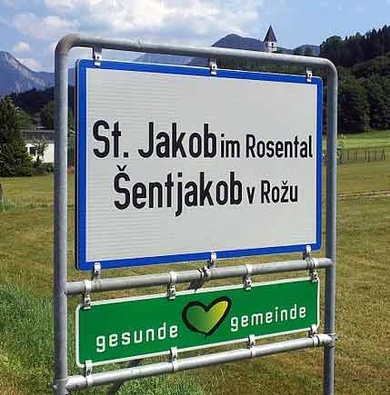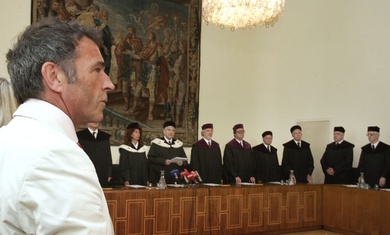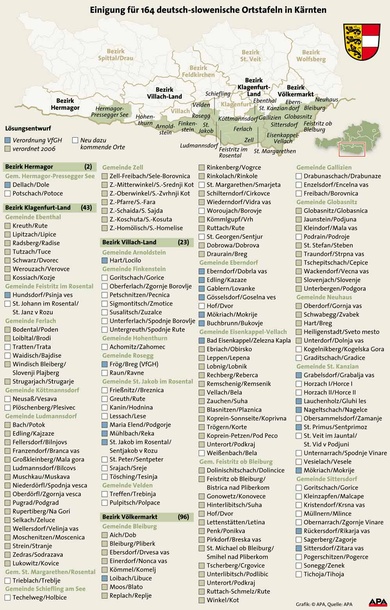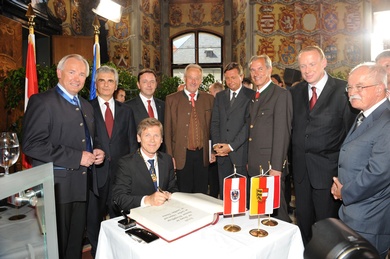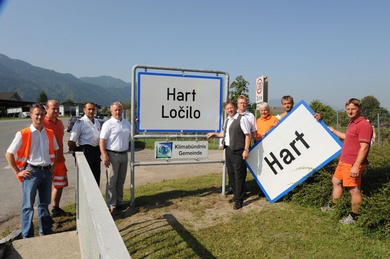Ten per cent: This was the minimum percentage of Slovene-speaking inhabitants in a Carinthian municipality required for a bilingual place name sign to be mandatory, as stated in the decision pronounced by the Constitutional Court on 13 December 2001 (VfSlg 16404). Previously, the Ethnic Groups Act had required a minimum of 25%. In the wake of its decision, the Constitutional Court found itself at the centre of a public debate of unprecedented intensity. Politicians of the Province of Carinthia, in particular, launched vehement attacks against the Constitutional Court and its President Ludwig Adamovich. The political agreement reached after ten years and several further Constitutional Court decisions finally set the minimum percentage at 17.5%.
Immediately after the Court’s decision in 2001, however, there was no agreement in sight. The Governor of the Province of Carinthia at the time, Jörg Haider (Freedom Party), supported by the Freedom Party at federal level, reacted with violent verbal attacks. He reproached Constitutional Court President Ludwig Adamovich for his “unworthy behaviour” and called for his resignation. His censure was directed at talks allegedly held by Adamovich with the President of Slovenia about the issue of place name signs prior the contested decision. President Adamovich refused to step down, but proposed that the allegations against him be clarified in impeachment proceedings. On 6 January 2002, the Constitutional Court (in the absence of President Adamovic) decided not to institute such proceedings (VfSlg 16408).
For the Court, however, the issue of place name signs was far from resolved. Attempts in subsequent years to arrive at a political solution (“Carinthian Consensus Conference”) failed. In the meantime, the Constitutional Court ruled that additional bilingual place name signs had to be put up (e.g. Bleiburg/Pliberk, Ebersdorf/Drveša vas, VfSlg 18044, 18318). Governor Haider tried to circumvent these decisions by having place name signs removed from their original location or replaced by signs in German with the Slovene name added on a smaller sign. None of these variants were acceptable to the Constitutional Court (e.g. VfSlg 17895, 19116).
The last in the long series of decisions was pronounced on 25 February 2011 (VfSlg 19313). A few weeks later, a political agreement was finally reached between the Federal Government (State Secretary Josef Ostermayer, Social-Democratic Party), the Province of Carinthia (Governor Gerhard Dörfler, Alliance for the Future of Austria) and representatives of the Slovene minority. On 6 July 2011, the National Council enacted the solution of the conflict by amending the Ethnic Groups Act (BGBl. I 46/2011). The provisions on bilingual place name signs as well as the list of municipalities concerned have since ranked as constitutional law. As a result of the Constitutional Court’s decisions, Carinthia now has 164 bilingual place name signs in municipalities with a Slovene-speaking population of at least 17.5%. Lists of this type were also drawn up and adopted for municipalities with Croatian and/or Hungarian minorities in Burgenland.
The issue of the Slovene-speaking minority in Carinthia is historically charged. Towards the end of the First World War, troops of the newly constituted Yugoslavia (called SHS in Serbo-Croatian: State of Slovenes, Croats and Serbs) occupied parts of Carinthia. The territorial conflict was finally resolved by the Carinthian plebiscite on 10 October 1920, in which a majority of votes were cast in favour of the contested areas remaining with Austria. Many years later, the protection of minorities was included in the Austrian State Treaty of 1955. Under Article 7, the languages of the Slovene and Croat minorities in the mixed-language regions of Carinthia, Burgenland and Styria enjoy the status of official languages, alongside German. Moreover, bilingual “topographical terminology and inscriptions” are to be used.
To implement this provision, in 1972 the Social-Democratic government under Federal Chancellor Bruno Kreisky decided to set up bilingual place name signs in 205 Carinthian municipalities with at least 20% Slovene-speaking inhabitants. The situation escalated: Opponents joined forces in the notorious “Ortstafelsturm” and tore down the new place name signs, and the whole campaign came to a halt. Finally, the 1976 Ethnic Groups Act drew the line for bilingual place name signs at 25% of the population. The 1977 Topography Regulation provided for 91 bilingual place name signs, but not all of them were put up.
20 years later, a lawyer brought the issue of place name signs before the Constitutional Court. He challenged the validity of a speeding ticket, arguing that the boundary of the territory of St. Kanzian was not properly marked, as bilingual place name signs were missing. The Constitutional Court used the occasion to initiate ex-officio review proceedings and pronounced its decision G 231/01 (VfSlg 16404) on 13 December 2005.
